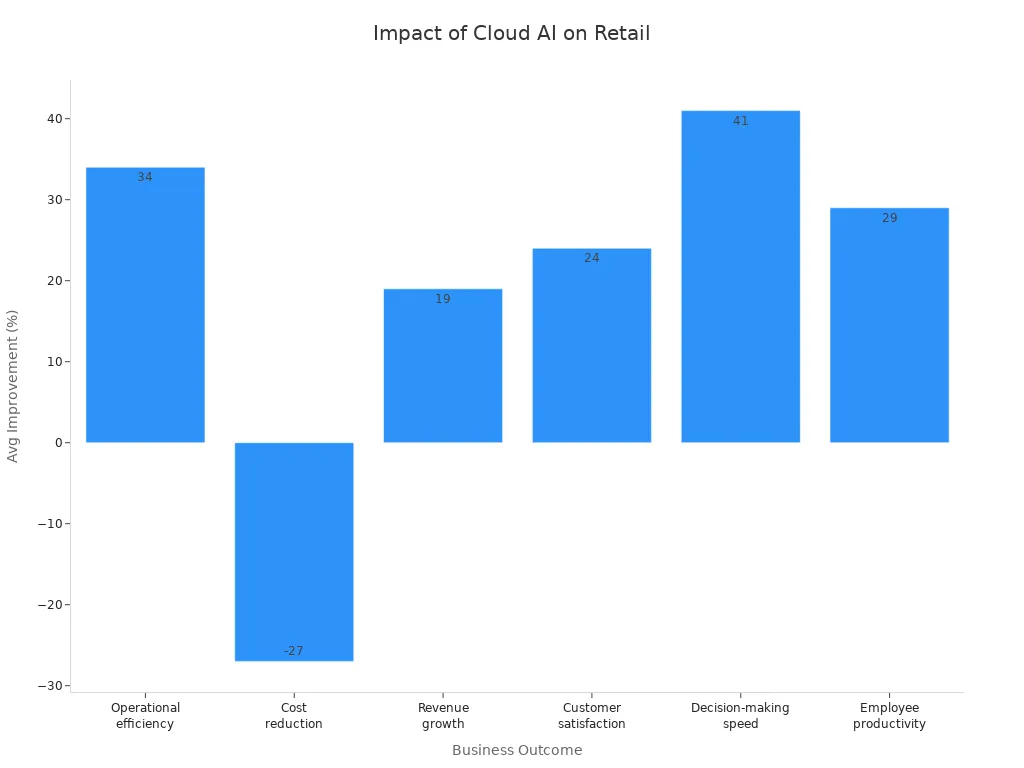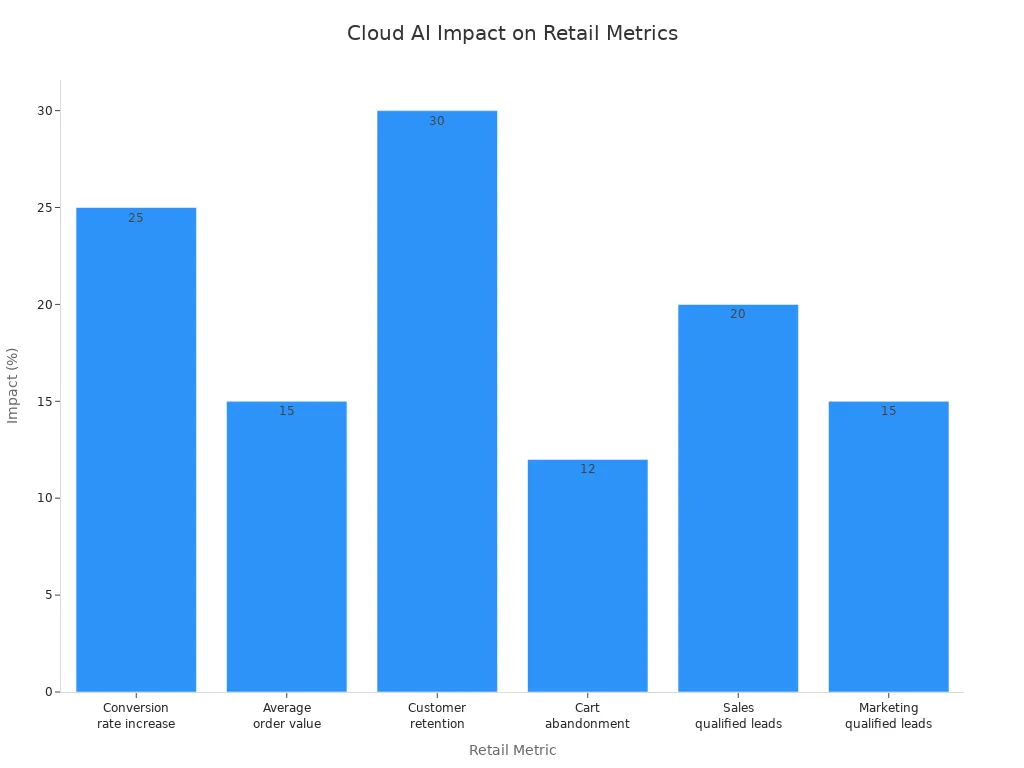Cloud AI platforms accelerate retail growth and efficiency

Cloud AI platforms help stores work better and grow faster. Stores need to change quickly because customers want new things. Companies get real benefits in many ways.
Business Outcome | Average Improvement | Time to Realize |
|---|---|---|
Operational efficiency | +34% | 6-12 months |
Cost reduction | -27% | 8-18 months |
Revenue growth | +19% | 12-24 months |
Customer satisfaction | +24% | 3-9 months |
Decision-making speed | +41% | 4-8 months |
Employee productivity | +29% | 6-15 months |

Top stores use cloud AI platforms to make shopping better for customers. These tools help stores work faster and make smart choices. Microsoft and Google Cloud help stores give shoppers what they want. This leads to more sales and better control of products.
Key Takeaways
Cloud AI platforms help stores work faster. They make stores smarter. They can improve how stores run by up to 34%.
Automation helps stores spend less money. It lowers costs by 27%. It also helps workers do more. Productivity goes up by 29%. Staff can spend more time helping customers.
Real-time analytics help stores make good choices fast. This makes customers happier by 24%.
AI helps stores use special marketing plans. These plans can help stores sell more. Some companies see sales go up by 250%.
Retailers should buy cloud AI tools. They should make their IT systems better. They need to keep data safe.
The impact of cloud AI platforms in retail
Driving growth with scalable AI
Retailers use cloud AI platforms to help their stores grow. These platforms work for big and small stores. Oracle Cloud for Retail, Blue Yonder, and Microsoft for Retail give tools for smart choices. Stores use AI agents to answer questions and help customers. Small stores get solutions that grow with them. Big companies use AI to find new ways to sell and make shopping better.
AI helps stores make good choices by looking at data fast. Predictive analytics show what customers want and when. This helps stores plan better and sell more. Stores can use automation for inventory checks and price changes. They save time and can do more important jobs.
Retailers get real results with scalable AI. They waste less, keep shelves full, and make more money each year.
Metric | Outcome |
|---|---|
Reduced from 12% to 7% | |
Fresh Product Availability | Improved by 15% |
Additional Gross Profit | Generated $340K annually |
AI changes how stores work. It helps stores grow by making things faster and more correct. Companies use cloud AI platforms to reach more people and keep customers coming back.
AI agents help customers any time.
Automation lets workers try new ideas.
Data helps stores plan for what’s next.
Boosting efficiency through automation
Automation changes how stores work every day. Cloud AI platforms do boring jobs so workers can help customers. AI systems learn from data and get smarter. This means fewer mistakes and better results.
Stores use automation for warehouses, checkout, and managing workers. Smart checkout makes shopping faster and has fewer errors. Automated inventory keeps track of products and fills shelves. Workers spend less time on simple jobs and more time on important work.
Automation lowers mistakes in easy jobs.
Stores grow without spending more money.
Customers get quick help from chatbots all day.
AI cloud services make stores up to 30% more efficient. Retailers make choices faster and keep costs down. Automation helps stores run well and keeps customers happy.
Benefit | Description |
|---|---|
AI makes work faster and cuts down on manual jobs. | |
Enhanced customer experience | Personal help and quick support make customers like the store more. |
Cost reduction | AI makes supply chains and store work better, so costs go down. |
Retailers use cloud AI platforms to automate important jobs. They get better results, more money, and happier customers. Stores that use automation stay ahead in a changing market.
Digital transformation in the retail landscape
Overcoming modern retail challenges
Retailers have many problems when they try to grow. Old systems make it hard to use new technology. Some workers do not want to try new tools. This means stores do not get all the value from what they buy. Data is often in different places and looks different. This makes it hard for stores to know what is going on. It is also hard to help customers in a special way. Many stores do not have enough skilled workers for digital tools. Some leaders cannot show how new technology helps make money.
Integration across fragmented systems
Resistance to change
Data silos and operational blind spots
Skills gaps and capacity constraints
Difficulty proving ROI
Stores must fix these problems to keep up with others. They need better ways to connect systems, teach workers, and use data.
Why cloud AI platforms are essential
Cloud AI platforms help stores fix these problems. They bring data together from many places. This makes it easy to use. Stores can teach workers with simple tools. Smart systems help workers do their jobs. Leaders can see results and know if things are working.
Many stores say cost is the biggest problem with new AI tools. Some people hope for too much from technology. Some get different answers from AI systems. The table below shows how often these problems happen:
Barrier to Scaling AI+BI Platforms | Percentage of Respondents |
|---|---|
Cost | 53% |
Unrealistic Expectations | 50% |
Inconsistent Answers from AI Tools | 35% |
Cloud AI platforms help stores spend less and set clear goals. They help stores make smart choices and grow. Stores that use these platforms can fix problems faster and help customers better.
AI personalization in retail

Real-time customer engagement
Stores use AI to connect with shoppers in new ways. Platforms like Oracle and Everseen help stores give special offers fast. Everseen's AI sends deals based on what is in stock and where shoppers are. For example, if a store has extra chicken sandwiches at 3:00 PM, the system sends messages to people nearby. Shoppers can buy quickly and skip the line. This makes shopping easier and more fun.
AI helps stores talk to shoppers using chatbots and smart assistants. These tools answer questions and give advice right away. Shoppers get help when they need it. Stores use AI to learn what shoppers like and suggest products that fit. This makes shoppers happier and helps stores sell more.
Personalized marketing strategies
Stores use cloud AI platforms to make marketing personal. AI looks at what shoppers buy and what they like. It suggests products and sends messages that match each person. This helps stores reach the right people with the right offers.
Many companies see big results from AI-driven marketing. One sales team saw leads go up by 110% and closed deals rise by 250%. Other brands also report strong gains:
Company | Metric Description | Result |
|---|---|---|
HP Tronic | Increase in conversions | 136% increase |
Amazon | Contribution of personalized recommendations | 35% of annual sales |
North Face | Boost in click-through rates | 60% increase |
Sephora | Increase in engagement and conversions | 30% engagement, 11% conversions |
Yves Rocher | Jump in clicks and conversions | 17.5x clicks, 11x conversions |
North Face uses a voice-powered AI assistant to boost click rates.
Sephora's AI tool helps more shoppers engage and buy.
Yves Rocher gets more clicks and sales with real-time suggestions.
Personalized marketing helps stores build loyalty. Shoppers come back because they feel understood. Stores grow as customers buy more and stay longer.
Optimizing operations and supply chain with AI

Inventory management and forecasting
Retailers use AI to make inventory work better and faster. Blue Yonder and Snowflake AI Data Cloud help stores see supply chain updates right away. These tools show what is happening now and help leaders pick smart choices. AI agents watch supply chains all the time and find problems early. They send alerts and tips so managers can fix things fast.
Stores use machine learning to guess what customers will buy. This helps them keep enough products on shelves. AI checks inventory and looks at sales data. This lowers mistakes and helps stores solve issues quickly. Walmart uses AI to manage inventory and has saved 10-15% in costs. Sales went up by 5-7% because stores can plan better.
AI is not just a small change; it is a big shift in inventory management.
Benefit | Description |
|---|---|
Stores see supply chain updates fast and make quick choices. | |
Enhanced decision-making | AI helps leaders pick the best actions using data. |
Stores finish jobs faster, sometimes in minutes not days. |
Automated logistics and replenishment
AI makes moving products and restocking easier for stores. Blue Yonder and Snowflake AI Data Cloud use smart agents to match supply with demand, watch transportation, and organize warehouse jobs. These agents help stores save money and work better.
A global logistics provider saved 15–20% in costs with AI automation.
One retailer had 40% fewer empty shelves, making customers happier.
Amazon tracks millions of items with AI to guess demand and keep products ready for fast delivery.
Target uses AI to study sales and automate restocking, so stores do not have too much or too little stock.
AI agents in logistics watch for problems and suggest new routes to save time and money. Warehouse agents move workers where they are needed most. Stores using cloud ai platforms see better accuracy and less waste.
AI agents watch supply chains and find problems early.
Machine learning helps stores guess demand and make smart choices.
Automated systems help stores keep shelves full and customers happy.
Enhancing omnichannel and in-store performance
AI-powered store management
Retailers use AI-powered tools to help stores run better. These tools let managers see inventory right away and make quick choices. Micro-retailers get help with smart order management and workforce planning. AI-driven customer service solves problems fast and makes shoppers happier. Dynamic inventory governance helps stores manage products in many places. This keeps shelves full and stops waste.
Feature | Benefit |
|---|---|
Shows correct stock and helps orders go out on time. | |
Intelligent fulfillment orchestration | Makes order handling smoother, so customers are happier. |
Makes talking to customers better and fixes problems fast. | |
Dynamic inventory governance | Helps stores handle products everywhere and earn more money. |
Advanced analytics | Gives stores tips to work better and improve how things run. |
AI-powered store management changes how shoppers buy things. Shoppers use apps to find items and get ideas if something is missing. Stores send special deals at checkout or on the shelf. Digital shelf labels change by themselves to show popular or seasonal items. AI changes prices quickly, so stores can compete and make more money.
AI helps stores manage inventory by doing jobs automatically and giving useful tips. This means stores have more products ready and use resources better.
Seamless online-offline integration
Cloud ai platforms help stores link online and in-person shopping. Customers get the same experience in stores and online. They can check stock, buy things, and return items easily. Stores use cloud computing to collect data from everywhere. This makes marketing and product deals smarter.
Omnichannel retail gives shoppers the same experience in stores, online, and on apps.
AI looks at data fast, so stores can help customers right away.
Shoppers get special deals and see correct prices wherever they shop.
Returns are easy, so people can buy online and return in stores.
Stores use digital tools to make ordering simple and see what distributors do. AI suggestions help stores work better and let micro-retailers order by themselves. This makes shopping easier and helps stores serve customers well.
Data-driven decision making with cloud AI platforms
Real-time analytics for insights
Retailers use real-time analytics to make smart choices. Platforms like Snowflake show what is happening now. Managers watch live data for sales and inventory. They also track what customers do in the store. This helps them act fast when things change.
Snowflake gives stores tools to load data by itself. Dashboards stay current with new information. Stores use change tracking to spot updates and problems. Workflow automation helps teams finish jobs quickly. These features help stores keep shelves full and customers happy.
Stores using real-time analytics fix problems before they grow. They see what customers want and change offers right away.
Here is a table showing how real-time analytics help stores:
Benefit | Description |
|---|---|
Real-Time Customer Analytics | Stores give personal offers based on what shoppers do now. |
Improved Decision-Making | Live data helps managers make better choices faster. |
Enhanced Operational Efficiency | Tracking inventory in real time keeps shelves stocked and customers happy. |
Automated Data Loading | Snowpipe brings in data all the time, so analytics are always fresh. |
Change Tracking | Streams watch for changes in data, keeping dashboards up to date. |
Workflow Automation | Tasks help teams finish work faster by automating steps. |
Gap Inc. uses Snowflake to put all their data together. Leaders see trends and make choices quickly. They plan sales, manage inventory, and help customers better. Stores using these tools decide faster and build loyalty.
Predictive modeling for planning
Predictive modeling helps stores get ready for the future. Cloud ai platforms use machine learning to study old sales and customer actions. These models guess what shoppers will buy soon. Stores use these guesses to order products and set prices.
Managers use predictive modeling to plan staff and promotions. They see which items will be popular and get ready for busy times. This helps stores avoid empty shelves and keeps customers happy.
Predictive modeling helps stores stay ahead of trends. They can plan for holidays, sales, and new products with confidence.
The table below shows how data-driven planning helps stores and customers:
Improvement Type | Description |
|---|---|
Personalized customer experiences | AI suggestions help customers find what they like and come back. |
Real-time pricing adjustments | Stores change prices fast to match demand and make more money. |
Optimized inventory management | Data helps stores keep enough products and avoid too much stock. |
Enhanced supply chain efficiency | AI helps stores deliver faster and spend less money. |
Improved employee productivity | Data tools help managers put workers where they are needed most. |
Better in-store experience | Stores use new tools to make shopping better and keep customers loyal. |
Stores using predictive modeling make smarter choices. Customers return more often and trust the store. Data-driven planning helps stores grow and compete.
Tip: Stores should use both real-time analytics and predictive modeling. This helps them act fast and plan ahead.
Adoption challenges and maximizing ROI
Addressing security and privacy
Retailers have problems when using cloud AI platforms. Security and privacy are big worries. Stores keep sensitive customer data. This makes stores a target for cyber threats. Weak security can cause data breaches. Data breaches hurt customer trust.
Some common security and privacy risks are:
Data Breaches: Hackers can steal important information if security is weak.
Misuse of Personal Information: AI tools might show private data by accident.
Adversarial Attacks: Bad people can trick AI systems by changing data.
Regulatory Compliance Issues: Using personal data in AI must follow strict rules.
Retailers can fix these risks by adding privacy from the start. They should use strong security steps and teach staff to spot threats. Following privacy laws and using secure cloud services helps protect stores and customers.
Tip: Retailers should check their security plans often and update them when new threats come.
Measuring success and scalability
Retailers need to see if cloud AI works well. They use key performance indicators (KPIs) and business outcomes to measure success. These numbers show how AI helps stores and customers.
Metric Type | Description | Example Use Case |
|---|---|---|
Measures how AI makes work faster and reduces manual effort. | AI-driven invoice processing cuts down on data entry mistakes. | |
Business Impact Metrics | Shows how AI boosts sales and customer satisfaction. | Personalized recommendations increase sales and make shoppers happier. |
AI-Specific Performance Metrics | Tracks how well AI models perform, including accuracy and fairness. | Checking model accuracy in credit scoring for better results. |
Retailers also face problems like high costs, system issues, and mistrust of AI choices. They can start with small projects to test value before growing bigger. Using cloud AI services lowers starting costs and makes scaling easier. Clear talks about AI’s benefits help build trust with workers and customers.
Note: Measuring short-term wins and long-term growth helps retailers get the most from cloud AI platforms.
The future of retail with cloud AI platforms
Emerging trends in retail AI
Stores see new technology changing how they work. Vision AI and digital tools help stores fix problems and grow. Computer vision AI lets stores watch shelves and track products. Google Vision AI and Amazon Rekognition use pictures and videos to help stores manage inventory and see what customers do. Everseen Vision Agents learn and change to make store jobs easier.
Innovation Type | Description |
|---|---|
Computer Vision AI | Helps stores connect with customers and solve worker shortages. |
Google Vision AI | Looks at pictures and videos right away to help with inventory and customer actions. |
Amazon Rekognition | Checks images and videos for cashier-less checkout and tracking products. |
Everseen Vision Agents | Learns by itself and makes store work smoother. |
Stores also use BigQuery and Vertex AI to make smart choices and help the planet. These tools show data from everywhere and guess what will happen next.
Technology Used | Benefit |
|---|---|
BigQuery | Helps stores make better choices and see all their data. |
Vertex AI | Makes supply chains work better and helps stores use less energy. |
Other new ideas are AI shopping helpers, visual search, smart inventory, changing prices, and generative AI for ads. AI helps stores talk to customers and waste less.
AI helpers and virtual agents help people find things and get advice.
Visual search lets shoppers upload pictures to find products.
Smart inventory guessing keeps shelves full and lowers losses.
Changing prices matches what is happening in the market.
Omnichannel AI gives shoppers a smooth experience.
AI helps stores waste less and be greener.
Generative AI makes new ads and product ideas.
Preparing for ongoing transformation
Stores must get ready for more changes. They use AI to guess sales and set prices. Making shopping personal helps stores give shoppers what they want. New POS systems work with the cloud and make inventory easier. Generative AI gives stores new ways to suggest products and talk to shoppers.
Strategy | Description |
|---|---|
Uses live data from POS systems to guess sales and set prices. | |
Personalizing User Experiences | Builds special shopper profiles for better suggestions. |
Modernizing POS Systems | Works with the cloud and gives shoppers more ways to buy. |
Implementing Generative AI | Gives personal ideas and helps stores talk to shoppers. |
Stores that use these ideas stay ahead. They build strong bonds with shoppers and make more money. AI will keep changing stores, so they must keep learning and trying new things.
Stores that use cloud AI platforms will lead in new ideas and happy customers. The future will have smarter stores, better shopping, and new ways to grow.
Cloud AI platforms help stores grow and work better. Stores get more sales and keep customers coming back. They also work faster and smarter. The table below shows how cloud AI helps stores do well:
Metric | Impact |
|---|---|
Conversion rate increase | 25% boost in conversion rates |
Average order value increase | 15% increase in average order value |
Customer retention improvement | 30% reduction in churn rate |
Cart abandonment rate reduction | 12% decrease in cart abandonment rates |
Sales qualified leads increase | |
Marketing qualified leads increase | 15% increase in marketing qualified leads |

Stores that want to do well should try these ideas:
Update IT systems so AI works in stores.
Use IoT devices for better data and safety.
Check contact center tools and look at AI platforms.
Make inventory steps better.
Set rules for using generative AI.
Keep private data safe and apart.
Work with people who know AI.
Cloud AI helps stores grow, change, and save money. Big companies like Wayfair use new AI tools to make shopping better and grow faster. Stores that use cloud AI will be leaders as technology keeps changing.
FAQ
What is a cloud AI platform in retail?
A cloud AI platform gives stores smart online tools. These tools help stores use data and guess sales. They also make customer service better. Stores use these platforms to work faster. They help stores make good choices.
How do cloud AI platforms help stores save money?
Cloud AI platforms do jobs like checking inventory and managing orders. Stores spend less money on manual work. They also make fewer mistakes. This helps stores lower costs and earn more profit.
Can small stores use cloud AI platforms?
Small stores can use cloud AI platforms too. Many platforms have plans that fit different needs. Stores pick what works for them and grow as they get bigger. Cloud AI helps small stores compete with large companies.
Are cloud AI platforms safe for customer data?
Cloud AI platforms use strong security tools to protect data. They keep customer information safe with encryption and regular checks. Stores follow privacy laws to keep data private.
See Also
The Future of Retail Lies in AI-Driven Stores
Transforming Online Retail Management with AI E-Commerce Tools
Essential Insights on AI-Enhanced Corner Stores for Retailers
Experience Cashierless Shopping Convenience with Cloudpick Solutions
Boosting Efficiency and Customer Experience with Cloudpick Technology
